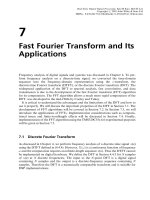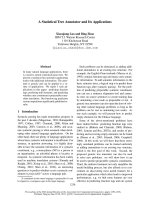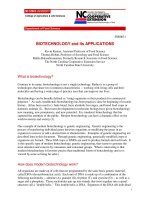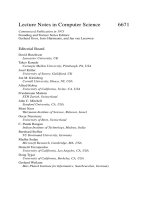BIOTECHNOLOGY and its APPLICATIONS
Bạn đang xem bản rút gọn của tài liệu. Xem và tải ngay bản đầy đủ của tài liệu tại đây (53.81 KB, 13 trang )
1
FSR0031
BIOTECHNOLOGY and its APPLICATIONS
Kevin Keener, Assistant Professor of Food Science
Thomas Hoban, Professor of Sociology and Food Science
Rekha Balasubramanian, Formerly Research Associate in Food Science
The North Carolina Cooperative Extension Service
North Carolina State University
What is biotechnology?
Contrary to its name, biotechnology is not a single technology. Rather it is a group of
technologies that share two (common) characteristics working with living cells and their
molecules and having a wide range of practice uses that can improve our lives.
Biotechnology can be broadly defined as "using organisms or their products for commercial
purposes." As such, (traditional) biotechnology has been practices since he beginning of records
history. (It has been used to:) bake bread, brew alcoholic beverages, and breed food crops or
domestic animals (2). But recent developments in molecular biology have given biotechnology
new meaning, new prominence, and new potential. It is (modern) biotechnology that has
captured the attention of the public. Modern biotechnology can have a dramatic effect on the
world economy and society (3).
One example of modern biotechnology is genetic engineering. Genetic engineering is the
process of transferring individual genes between organisms or modifying the genes in an
organism to remove or add a desired trait or characteristic. Examples of genetic engineering are
described later in this document. Through genetic engineering, genetically modified crops or
organisms are formed. These GM crops or GMOs are used to produce biotech-derived foods. It
is this specific type of modern biotechnology, genetic engineering, that seems to generate the
most attention and concern by consumers and consumer groups. What is interesting is that
modern biotechnology is far more precise than traditional forms of biotechnology and so is
viewed by some as being far safer.)
How does modern biotechnology work?
All organisms are made up of cells that are programmed by the same basic genetic material,
called DNA (deoxyribonucleic acid). Each unit of DNA is made up of a combination of the
following nucleotides adenine (A), guanine (G), thymine (T), and cytosine (D) as well as a
sugar and a phosphate. These nucleotides pair up into strands that twist together into a spiral
structure call a "double helix." This double helix is DNA. Segments of the DNA tell individual
2
cells how to produce specific proteins. These segments are genes. It is the presence or absence
of the specific protein that gives an organism a trait or characteristic. More than 10,000 different
genes are found in most plant and animal species. This total set of genes for an organism is
organized into chromosomes within the cell nucleus. The process by which a multicellular
organism develops from a single cell through an embryo stage into an adult is ultimately
controlled by the genetic information of the cell, as well as interaction of genes and gene
products with environmental factors. (5)
When cells reproduce, the DNA strands of the double helix separate. Because nucleotide A
always pairs with T and G always pairs with C, each DNA strand serves as a precise blueprint
for a specific protein. Except for mutations or mistakes in the replication process, a single cell is
equipped with the information to replicate into millions of identical cells. Because all organisms
are made up of the same type of genetic material (nucleotides A, T, G, and C), biotechnologists
use enzymes to cut and remove DNA segments from one organism and recombine it with DNA
in another organism. This is called recombinant DNA (rDNA) technology, and it is one of the
basic tools of modern biotechnology (6). rDNA technology is the laboratory manipulation of
DNA in which DNA, or fragments of DNA from different sources, are cut and recombined using
enzymes. This recombinant DNA is then inserted into a living organism. rDNA technology is
usually used synonymously with genetic engineering. rDNA technology allows researchers to
move genetic information between unrelated organisms to produce desired products or
characteristics or to eliminate undesirable characteristics.
Genetic engineering is the technique of removing, modifying or adding genes to a DNA
molecule in order to change the information it contains. By changing this information, genetic
engineering changes the type or amount of proteins an organism is capable of producing. Genetic
engineering is used in the production of drugs, human gene therapy, and the development of
improved plants (2). For example, an “insect protection” gene (Bt) has been inserted into several
crops - corn, cotton, and potatoes - to give farmers new tools for integrated pest management. Bt
corn is resistant to European corn borer. This inherent resistance thus reduces a farmers pesticide
use for controlling European corn borer, and in turn requires less chemicals and potentially
provides higher yielding Agricultural Biotechnology.
Although major genetic improvements have been made in crops, progress in conventional
breeding programs has been slow. In fact, most crops grown in the US produce less than their
full genetic potential. These shortfalls in yield are due to the inability of crops to tolerate or adapt
to environmental stresses, pests, and diseases. For example, some of the world's highest yields of
potatoes are in Idaho under irrigation, but in 1993 both quality and yield were severely reduced
because of cold, wet weather and widespread frost damage during June. Some of the world's best
bread wheats and malting barleys are produced in the north-central states, but in 1993 the disease
Fusarium caused an estimated $1 billion in damage.
Scientists have the ability to insert genes that give biological defense against diseases and
insects, thus reducing the need for chemical pesticides, and they will soon be able to convey
genetic traits that enable crops to better withstand harsh conditions, such as drought (8). The
International Laboratory for Tropical Agricultural Biotechnology (ILTAB) is developing
transformation techniques and applications for control of diseases caused by plant viruses in
tropical plants such as rice, cassava and tomato. In 1995, ILTAB reported the first transfer
through biotechnology of a resistance gene from a wild species of rice to a susceptible cultivated
rice variety. The transferred gene expressed resistance to Xanthomonas oryzae, a bacterium
which can destroy the crop through disease. The resistant gene was transferred into susceptible
rice varieties that are cultivated on more than 24 million hectares around the world (9).
3
Benefits can also be seen in the environment, where insect-protected biotech crops reduce the
need for chemical pesticide use. Insect-protected crops allow for less potential exposure of
farmers and groundwater to chemical residues, while providing farmers with season-long
control. Also by reducing the need for pest control, impacts and resources spent on the land are
less, thereby preserving the topsoil (10).
Major advances also have been made through conventional breeding and selection of livestock,
but significant gains can still be made by using biotechnology (23). Currently, farmers in the U.S
spend $17 billion dollars on animal health. Diseases such as hog cholera and pests such as
screwworm have been eradicated. Uses of biotechnology in animal production include
development of vaccines to protect animals from disease, production of several calves from one
embryo (cloning), increase of animal growth rate, and rapid disease detection (7).
Modern biotechnology has offered opportunities to produce more nutritious and better tasting
foods, higher crop yields and plants that are naturally protected from disease and insects. Modern
biotechnology allows for the transfer of only one or a few desirable genes, thereby permitting
scientists to develop crops with specific beneficial traits and reduce undesirable traits (10).
Traditional biotechnology such as cross-pollination in corn produces numerous, non-selective
changes. Genetic modifications have produced fruits that can ripen on the vine for better taste,
yet have longer shelf lives through delayed pectin degradation (7). Tomatoes and other produce
containing increased levels of certain nutrients, such as vitamin C, vitamin E, and or beta
carotene, and help protect against the risk of chronic diseases, such as some cancers and heart
disease. (10). Similarly introducing genes that increase available iron levels in rice three-fold is a
potential remedy for iron deficiency, a condition that effects more than two billion people and
causes anemia in about half that number (19). Most of the today's hard cheese products are made
with a biotech enzyme called chymosin. This is produced by genetically engineered bacteria
which is considered more purer and plentiful than it’s naturally occurring counterpart, rennet,
which is derived from calf stomach tissue.
In 1992, Monsanto Company successfully inserted a gene from a bacterium into the Russet
Burbank potato. This gene increases the starch content of the potato. Higher starch content
reduces oil absorption during frying, thereby lowering the cost of processing french fries and
chips and reducing the fat content in the finished product. This product is still awaiting final
development and approval.
Modern biotechnology offers effective techniques to address food safety concerns. Biotechnical
methods may be used to decrease the time necessary to detect foodborne pathogens, toxins, and
chemical contaminants, as well as to increase detection sensitivity. Enzymes, antibodies, and
microorganisms produced using rDNA techniques are being used to monitor food production and
processing systems for quality control (7).
Biotechnology can compress the time frame required to translate fundamental discoveries into
applications. This is done by controlling which genes are altered in an organized fashion. For
example, a known gene sequence from a corn plant can be altered to improve yield, increase
drought tolerance, and produce insect resistance (Bt) in one generation. Conventional breeding
techniques would take several years. Conventional breeding techniques would require that a field
of corn is grown and each trait is selected from individual stalks of corn. The ears of corn from
selected stalks with each desired trait (e.g, drought tolerance and yield performance) would then
be grown and combined (cross-pollinated). Their offspring (hybrid) would be further selected for
the desired result (a high performing corn with drought tolerance). With improved technology
4
and knowledge about agricultural organisms, processes, and ecosystems, opportunities will
emerge to produce new and improved agricultural products in an environmentally sound manner.
In summary, modern biotechnology offers opportunities to improve product quality, nutritional
content, and economic benefits. The genetic makeup of plants and animals can be modified by
either insertion of new useful genes or removal of unwanted ones. Biotechnology is changing the
way plants and animals are grown, boosting their value to growers, processors, and consumers
(3).
Industrial Biotechnology
Industrial biotechnology applies the techniques of modern molecular biology to improve the
efficiency and reduce the environmental impacts of industrial processes like textile, paper and
pulp, and chemical manufacturing. For example, industrial biotechnology companies develop
biocatalysts, such as enzymes, to synthesize chemicals. Enzymes are proteins produced by all
organisms. Using biotechnology, the desired enzyme can be manufactured in commercial
quantities.
Commodity chemicals (e.g., polymer-grade acrylamide) and specialty chemicals can be
produced using biotech applications. Traditional chemical synthesis involves large amounts of
energy and often-undesirable products, such as HCl. Using biocatalysts, the same chemicals can
be produced more economically and more environmentally friendly. An example would be the
substitution of protease in detergents for other cleaning compounds. Detergent proteases, which
remove protein impurities, are essential components of modern detergents. They are used to
break down protein, starch, and fatty acids present on items being washed. Protease production
results in a biomass that in turn yields a useful byproduct- an organic fertilizer. Biotechnology is
also used in the textile industry for the finishing of fabrics and garments. Biotechnology also
produces biotech-derived cotton that is warmer, stronger, has improved dye uptake and retention,
enhanced absorbency, and wrinkle- and shrink-resistance.
Some agricultural crops, such as corn, can be used in place of petroleum to produce chemicals.
The crop’s sugar can be fermented to acid, which can be then used as an intermediate to produce
other chemical feedstocks for various products. It has been projected that 30% of the world’s
chemical and fuel needs could be supplied by such renewable resources in the first half of the
next century. It has been demonstrated, at test scale, that biopulping reduces the electrical energy
required for wood pulping process by 30% (11).
Environmental Biotechnology
Environmental biotechnology is the used in waste treatment and pollution prevention.
Environmental biotechnology can more efficiently clean up many wastes than conventional
methods and greatly reduce our dependence on methods for land-based disposal.
Every organism ingests nutrients to live and produces by-products as a result. Different
organisms need different types of nutrients. Some bacteria thrive on the chemical components of
waste products. Environmental engineers use bioremediation, the broadest application of
environmental biotechnology, in two basic ways. They introduce nutrients to stimulate the
activity of bacteria already present in the soil at a waste site, or add new bacteria to the soil. The
5
bacteria digest the waste at the site and turn it into harmless byproducts. After the bacteria
consume the waste materials, they die off or return to their normal population levels in the
environment.
Bioremediation, is an area of increasing interest. Through application of biotechnical methods,
enzyme bioreactors are being developed that will pretreat some industrial waste and food waste
components and allow their removal through the sewage system rather than through solid waste
disposal mechanisms. Waste can also be converted to biofuel to run generators. Microbes can be
induced to produce enzymes needed to convert plant and vegetable materials into building blocks
for biodegradable plastics (7).
In some cases, the byproducts of the pollution-fighting microorganisms are themselves useful.
For example, methane can be derived from a form of bacteria that degrades sulfur liquor, a waste
product of paper manufacturing. This methane can then be used as a fuel or in other industrial
processes.
Human Applications
Biotechnical methods are now used to produce many proteins for pharmaceutical and other
specialized purposes. A harmless strain of Escherichia coli bacteria, given a copy of the gene for
human insulin, can make insulin. As these genetically modified (GM) bacterial cells age, they
produce human insulin, which can be purified and used to treat diabetes in humans.
Microorganisms can also be modified to produce digestive enzymes. In the future, these
microorganisms could be colonized in the intestinal tract of persons with digestive enzyme
insufficiencies (7). Products of modern biotechnology include artificial blood vessels from
collagen tubes coated with a layer of the anticoagulant heparin (12).
Gene therapy – altering DNA within cells in an organism to treat or cure a disease – is one of the
most promising areas of biotechnology research. New genetic therapies are being developed to
treat diseases such as cystic fibrosis, AIDS and cancer (6).
DNA fingerprinting is the process of cross matching two strands of DNA. In criminal
investigations, DNA from samples of hair, bodily fluids or skin at a crime scene are compared
with those obtained from the suspects. In practice, it has become one of the most powerful and
widely known applications of biotechnology today. Another process, polymerase chain reaction
(PCR), is also being used to more quickly and accurately identify the presence of infections such
as AIDS, Lyme disease and Chlamydia.
Paternity determination is possible because a child’s DNA pattern is inherited, half from the
mother and half from the father. To establish paternity, DNA fingerprints of the mother, child
and the alleged father are compared. The matching sequences of the mother and the child are
eliminated from the child’s DNA fingerprint; what remains comes from the biological father.
These segments are then compared for a match with the DNA fingerprint of the alleged father.
DNA testing is also used on human fossils to determine how closely related fossil samples are
from different geographic locations and geologic areas. The results shed light on the history of
human evolution and the manner in which human ancestors settled different parts of the world
(13).
6
Biotechnology for the 21
st
century
Experts in United States anticipate the world’s population in 2050 to be approximately 8.7
billion persons. The world’s population is growing, but its surface area is not. Compounding the
effects of population growth is the fact that most of the earth’s ideal farming land is already
being utilized. To avoid damaging environmentally sensitive areas, such as rain forests, we need
to increase crop yields for land currently in use. By increasing crop yields, through the use of
biotechnology the constant need to clear more land for growing food is reduced.
Countries in Asia, Africa, and elsewhere are grappling with how to continue feeding a growing
population. They are also trying to benefit more from their existing resources. Biotechnology
holds the key to increasing the yield of staple crops by allowing farmers to reap bigger harvests
from currently cultivated land, while preserving the land’s ability to support continued farming.
Malnutrition in underdeveloped countries is also being combated with biotechnology. The
Rockefeller Foundation is sponsoring research on “golden rice”, a crop designed to improve
nutrition in the developing world. Rice breeders are using biotechnology to build Vitamin A into
the rice. Vitamin A deficiency is a common problem in poor countries. A second phase of the
project will increase the iron content in rice to combat anemia, which is widespread problem
among women and children in underdeveloped countries. Golden rice, expected to be for sale in
Asia in less than five years, will offer dramatic improvements in nutrition and health for millions
of people, with little additional costs to consumers.
Similar initiatives using genetic manipulation are aimed at making crops more productive by
reducing their dependence on pesticides, fertilizers and irrigation, or by increasing their
resistance to plant diseases (14).
Increased crop yield, greater flexibility in growing environments, less use of chemical pesticides
and improved nutritional content make agricultural biotechnology, quite literally, the future of
the world’s food supply.
Concerns about Biotechnology
As biotechnology has become widely used, questions and concerns have also been raised. The
most vocal opposition has come from European countries. One of the main areas of concern is
the safety of genetically engineered food (7).
In assessing the benefits and risks involved in the use of modern biotechnology, there are a series
of issues to be addressed so that informed decisions can be made. In making value judgments
about risks and benefits in the use of biotechnology, it is important to distinguish between
technology-inherent risks and technology-transcending risks. The former includes assessing any
risks associated with food safety and the behavior of a biotechnology-based product in the
environment. The latter involve the political and social context in which the technology is used,
including how these uses may benefit or harm the interests of different groups in society.
The health effects of foods grown from genetically engineered crop depend on the composition
of the food itself. Any new product may have either beneficial or occasional harmful effects on
human health. For example, a biotech-derived food with a higher content of digestible iron is
likely to have a positive effect if consumed by iron-deficient individuals. Alternatively, the
transfer of genes from one species to another may also transfer the risk for exposure to allergens.
These risks are systematically evaluated by FDA and identified prior to commercialization.
7
Individuals allergic to certain nuts, for example, need to know if genes conveying this trait are
transferred to other foods such as soybeans. Labeling would be required if such crops were
available to consumers.
Among the potential ecological risks identified are increased weediness, due to cross- pollination
from genetically modified crops spreads to other plants in nearby fields. This may allow the
spread of traits such as herbicide-resistance to non-target plants that could potentially develop
into weeds. This ecological risk is assessed when deciding if a plant with a given trait should be
released into a particular environment, and if so, under what conditions.
Other potential ecological risks stem from the use of genetically modified corn and cotton with
insecticidal genes from Bacillus thuringiensis (Bt genes). This may lead to the development of
resistance to Bt in insect populations exposed to the biotech-derived crop. There also may be
risks to non-target species, such as birds and butterflies, from the plants with Bt genes. The
monitoring of these effects of new crops in the environment and implementation of effective risk
management approaches is an essential component of further research. It is also important to
keep all risks in perspective by comparing the products of biotechnology and conventional
agriculture.
The reduction of biodiversity would represent a technology-transcending risk. Reduced
biological diversity due to destruction of tropical forests, conversion of land to agriculture,
overfishing, and the other practices to feed a growing world population is a significant loss far
more than any potential loss of biodiversity due to biotech-derived crop varieties. Improved
governance and international support are necessary to limit loss of biodiversity (19).
What we know from our understanding of science and more than a decade of experience with
biotech-derived plants is the following (22): There is no evidence that genetic transfers between
unrelated organisms pose human health concerns that are different from those encountered with
any new plant or animal variety. The risks associated with biotechnology are the same as those
associated with plants and microbes developed by conventional methods.
Consumer and Food Industry Perspectives
Survey research over the past decade shows that biotechnology is not likely to become an
important issue for most American consumers. Consumers find biotechnology acceptable when
they believe it offers benefits and it is safe. Surveys have consistently found that a majority of
American consumers are willing to buy insect-protected food crops developed through
biotechnology that use fewer chemical pesticides, as well as more nutritious foods. American
consumers also appreciate the role that biotechnology can play in feeding the world. Research
shows that European consumers are much less supportive of all biotechnology applications.
Surveys since 1992 show that relatively few U.S. consumers have heard or read much about
biotechnology (26). News about the cloned sheep pushed awareness to 50 percent in March
1997. Surveys in the first three months of 2000 show that awareness has fallen back to just over
one-third in the United States. Such trends reflect the fact that most people get their information
about biotechnology from the media. Unfortunately, many consumers also do not understand
some fundamental principles of biology. European consumer awareness is somewhat higher, but
knowledge is still low.
Media coverage in the United States has generally been balanced (which helps account for our
relatively high levels of acceptance). This is in sharp contrast to the European media, which
8
have played upon fear of the unknown. The European media have also tended to accept
opponents' claims without question. Another issue is that many people no longer have a
connection to agriculture. In fact, research has shown that many consumers are unaware that all
foods are derived from plants or animals that already have been genetically modified through
traditional (but imprecise) breeding methods.
American consumers look to health professionals and scientific experts for credible information,
but place relatively little trust in the activists who oppose biotechnology. Research shows that
acceptance increases significantly when American consumers learn that organizations such as the
National Academy of Sciences and the U.S. Food and Drug Administration have determined that
biotech-derived foods are safe. In contrast, European consumers express the most trust in those
groups that oppose biotechnology. They have much less confidence in government, industry, or
even scientists. American culture is more supportive and rewarding of new technology.
Europeans tend to view food differently from U.S. consumers. In fact, some Europeans reject all
American food products. Europeans also want to protect their small farms to maintain open
space and rural employment. Such forces underlie much of the European anxiety about
agricultural biotech - especially since it is seen as an "American invention."
Most of the industry leaders interviewed are quite enthusiastic about the benefits of
biotechnology especially in terms of increased food availability, enhanced nutrition, and
environmental protection. Most feel that biotechnology has already provided benefits to
consumers. Almost all recognize that foods developed through biotechnology have already been
part of consumers' everyday diet. They clearly do not agree with most of the opponents' claims
and tend to have almost no trust in such groups.
Their main concerns involve lack of consumer acceptance not the safety of the foods. They
express high levels of confidence in the science and the regulatory process. In fact, almost none
feel that biotechnology should not be used because of uncertain, potential risks. Most food
industry leaders do not feel it is necessary to have special labels on biotech-derived foods. They
express concerns that such labels would be perceived as a warning by consumers. They also
worried that the need to segregate commodities would pose financial and logistical burdens on
everyone in the system - including consumers. Food industry leaders recognize a major need to
educate the public about biotechnology. They look to third parties, such as university and
government scientists to provide such leadership.
Research shows that consumers will accept biotech foods if they see a benefit to themselves or
society and if the price is right. Their responses to foods developed through biotechnology are
basically the same as for any other food - taste, nutrition, price, safety and convenience are the
major factors that influence our decisions about which foods to eat. How seeds and food
ingredients are developed will only be relevant for a relatively small group of concerned,
consumers.
The potential for public concerns has led several food companies to change their products to
avoid biotech-derived ingredients. For example, Gerber Foods received threats from Greenpeace
because they had determined the company was using biotech-derived food ingredients (mainly
soy). The company firmly believes that the biotech foods are safe to consume. Gerber agreed to
drop some of its existing corn and soybean suppliers in favor of ones that can produce crops that
are not genetically altered. It became an issue that is suddenly confronting other food companies.
A private manufacturer in California, called Healthy Times Natural Food has switched from
Canola oil (which sometimes is genetically modified) to safflower oil after facing questions from
9
Greenpeace. The controversy is due in part to the fact that the organic industry is using public
concern as a tool for marketing their products as free of biotech ingredients.
National and International Biotechnology Policy
National governments and international policy making bodies rely on food scientists and others
to develop innovations that will create marketable food products and increase food supplies.
Governments also rely on scientific research because they are responsible for setting health and
safety standards regarding new developments. International organizations can suggest policy
approaches and help develop international treaties that are ratified by national governments.
Economic success in the competitive international market demands that food production become
more efficient and profitable. National governments and international organizations support food
biotechnology as a means to avoid global food shortages. Many policy making bodies are also
trying to balance support of the food biotechnology industry with public calls for their
regulation. Such regulations are necessary to protect public health and safety, to promote
international trade, conserve natural resources, and account for ethical issues. (15).
The majority of processed foods on the market contain soy or corn ingredients that come from
GM plants. To date none have posed a food safety risk. The chief safety concerns are the
potential to alter nutrient content or introduce allergens. Federal agencies involved in
biotechnology regulation include the U.S. Department of Agriculture (USDA) which evaluates
agricultural production processes for all foods; the Food and Drug Administration (FDA), which
evaluates whole non-animal foods (seafood), food ingredients, and food additives; and the
Environmental Protection Agency (EPA), which evaluates plants with insecticidal properties (7).
Developers of GM plants and biotech-derived foods are required to consult with FDA prior to
the commercialization of the product. This consultation procedure entails a science-based safety
assessment of the product that focuses on the protection of the consumer, developer, and the
environment. Thus developers, have a strong incentive to cooperate fully with FDA and the other
agencies prior to marketing their products.
Labeling Issues
Labeling food derived from GM plants and animals is an important, but complex issue. Some
consumers and consumer groups believe they have a right to know whether biotechnology was
used to produce food. Others believe labeling is not necessary if foods are essentially equivalent
in composition. Food labels are regulated by FDA and, in some cases, by USDA. Regulatory
agencies are concerned with ensuring that food labels are both true and not misleading (7). In
accordance with their statutory mandate, the FDA has determined that a food product should be
labeled as a product of biotechnology only if it has been changed in some significant way. The
U.S. Court of Appeals recently reaffirmed that the FDA’s labeling policy is correct.
Based on the input from three public hearings, the FDA has recognized that the most effective
way to allow for informed choice will be a system of voluntary labeling for foods not produced
through biotechnology. If the demand for “GM-free” food is real, a market will become viable.
In this case, meaningful choice can be provided to concerned consumers without imposing costs
on or denying benefits to the majority of consumers, who support biotechnology. This may be
10
the only viable and cost-effective option for the food industry (given the costs and difficulties
associated with segregation and identity preservation.)
National surveys conducted with American consumers between 1997 and 2000 found about
three-quarters of consumers supported this FDA labeling policy (17). There is evidence from
focus groups that US consumers are already overwhelmed by the level of detail on food labels
and mainly look for relevant information about nutrition. Recent focus groups have
demonstrated that the wording on labels has a significant effect on consumer understanding and
acceptance of biotechnology. Any label messages need to be simple and clear. However,
labeling will be counterproductive without education.
It is important to understand when FDA will and won't require a product label. The same
labeling laws that apply to all other foods and food ingredients apply to products of food
biotechnology. Requirements for all food labels mandate proper identification of products and
notice of health or safety concerns. Labeling would be required in the following instances - but
not simply because the products were made using biotechnology (16).
* Potential food allergy is an example of a health or safety risk that would mandate a product
label (e.g., if a gene has been transferred from a known allergen, such as a peanut).
* When substantial changes have been made to the expected nutritional composition of a food
(e.g., vitamins have been added to a particular type of produce).
* If the common identity of a food product has been changed (e.g., if the composition of a fruit
or vegetable becomes significantly different it would have to have a different name).
Labeling of biotech-derived foods will be required in some countries (such as Japan and the
European Union) for cultural and religious reasons. These countries also believe labeling should
be required simply because the consumers want to know more about the content of the food or
how it was produced (19). Some have suggested that such labeling initiatives have been driven
by economic and political interests rather than by scientific need. Consumers in these countries
will ultimately end up paying even higher prices for their food as a result of such strict labeling
policies.
Summary
The applications of biotechnology are so broad, and the advantages so compelling, that virtually
every industry is using this technology. Developments are underway in areas as diverse as
pharmaceuticals, diagnostics, textiles, aquaculture, forestry, chemicals, household products,
environmental cleanup, food processing and forensics to name a few. Biotechnology is enabling
these industries to make new or better products, often with greater speed, efficiency and
flexibility (1). Biotechnology holds significant promise to the future but certain amount of risk is
associated with any area. Biotechnology must continue to be carefully regulated so that the
maximum benefits are received with the least risk.
Biotechnology is at a crossroads in terms of public acceptance. Many Americans have not yet
formed a solid opinion on this complex issue. International developments over the next few
years will certainly have a major influence on the long-term viability of biotechnology. The
future of the world food supply depends upon how well scientists, government, and the food
11
industry are able to communicate with consumers about the benefits and safety of the
technology.
Several major initiatives are under way to strengthen the regulatory process and to communicate
more effectively with consumers. Both the USDA and FDA have opened their regulatory
systems to outside review and public comment. The biotechnology industry, university scientists
and others are also conducting educational programs (27). These should further strengthen
consumer confidence. This partnership among the public and private sectors will support these
emerging technologies that will prove vital to the U.S. economy and the developing world in the
new millennium. Even Europe will soon find the real benefits of biotechnology compelling.
REFERENCES
1- North Carolina Biotechnology Center. “About Biotech”.
2- Principles of Biotechnology.
3- Biotechnology for the 21
st
Century: New Horizons.
4- Definition of Biotechnology-Economic Research Service at United States Department of
Agriculture.
5- United States Department of Agriculture “Agricultural Biotechnology Concepts and
Definitions”.
6- Bio’s guide to Biotechnology.
7- Journal of the American Dietetic Association “Position of the American Dietetic
Association: Biotechnology and the Future of Food.
8- What The Experts Say About Food Biotechnology
9- Food Biotechnology-Benefits for the Developing Countries.
10- Backgrounder- Food Biotechnology.
11- Bio’s guide to Biotechnology.
12- Press Releases.
13- Bio’s guide to Biotechnology.
12
New York Times Editorial, titled: “Food….people who would have the most to lose”,
November 19,1999.
15- National and International Policy Making in Biotechnology.
16- Food Biotechnology: Health and Harvest for Our Times.
17- IFIC Foundation- Americans Remain Positive on Food Biotechnology.
18- Myths and Facts about Food Biotechnology, Food Insight, September/October 1999, PP
2-3.
19- Council for Agricultural Science and Technology: “Applications of Biotechnology to
Crops: Benefits and Risks”, Issue Paper, Number 12, Dec. 1999.
20- U.S. Food and Drug Administration Center for food Safety and Applied Nutrtion: Q & A
Sheet: June 1992.
21- U.S. Food and Drug Administration Center for food Safety and Applied Nutrtion:
October-November 1997.
22- Genetically Engineered Foods, Fears and Facts: FDA. Consumer 27(1). January/February
1993, pp11-14.
23- Bio’s editors’ and reporters’ guide to biotechnology.
24- Hoban TJ, Kendall PA. Consumer Attitudes about Food Biotechnology. Project Report
1993, Raleigh, NC: North Carolina State University and Colorado State University;
1993:1-36.
25- Bruhn CM. Consumer concerns and educational strategies: focus on biotechnology, Food
Technology 1992,46(3):80-102
26- Public Perceptions of Biotechnology. A Summary of Research by Dr. Thomas Hoban at
North Carolina State University.
27- The Council for Biotechnology Information.
Biotechnology Glossary
BIOMASS: Material produced by or remaining after the death of organisms (e.g., bacteria,
plants, and animals).
BIOTECHNOLOGY: A collection of technologies that use living cells and/or biological
molecules to solve problems and make useful products.
13
BIOREMEDIATION: The use of organisms, usually microorganisms, to break down pollutants
in soil, air or groundwater.
DNA (Deoxyribonucleic acid): The chemical molecule that is the basic genetic material found
in all cells. Each unit of DNA is made of nucleotides: adenine (A), guanine (G), thymine (T) and
cytosine (C), as well as a sugar and a phosphate. DNA is inherited. DNA is a very long, thin
molecule, it is packaged into units called chromosomes.
ENZYMES: A protein that accelerates the rate of chemical reactions. Enzymes are catalysts that
promote reactions repeatedly, without being damaged by the reactions.
GENE: A unit of hereditary information. A gene is a section of a DNA molecule that specifies
the production of a particular protein.
GENETIC ENGINEERING: The technique of removing, modifying or adding genes to a DNA
molecule in order to change the information it contains. By changing this information, genetic
engineering changes the type or amount of proteins an organism is capable of producing.
GENETICALLY MODIFIED ORGANISM: An organism that has been modified, or
transformed, using modern techniques of genetic exchange is commonly referred to as a
genetically-modified organism (GMO).
GENE THERAPY: Altering DNA within cells in a living organism to treat or cure a disease. It
is one of the most promising areas of biotechnology research. New genetic therapies are being
developed to treat diseases such as cystic fibrosis, AIDS and cancer.
GENOME: The complete set of an organisms genetic information. In humans this corresponds
to twenty-three pairs of chromosomes.
MOLECULAR BIOLOGY: A branch of biology concerned with studying the chemical
structures and processes of biological phenomena at the molecular level
PLANT BREEDING: It is the technique involving crossing plants to produce varieties with
particular characteristics (traits) which are carried in the genes of the plants and passed on to
future generations.
RECOMBINANT DNA: DNA that is formed by combining DNA from two different sources.
Humans direct formation of recombinant DNA through selective breeding and genetic
engineering
RECOMBINANT DNA (rDNA) TECHNOLOGY: The laboratory manipulation of DNA in
which DNA, or fragments of DNA from different sources, are cut and recombined using
enzymes. This recombinant DNA is then inserted into a living organism. rDNA technology is
usually used synonymously with genetic engineering.
TRANSGENIC PLANT: Genetically engineered plant or offspring of genetically engineered
plants. Transgenic plants result from the insertion of genetic material from another organism so
that the plant will exhibit a desired trait. Recombinant DNA techniques are usually used.









